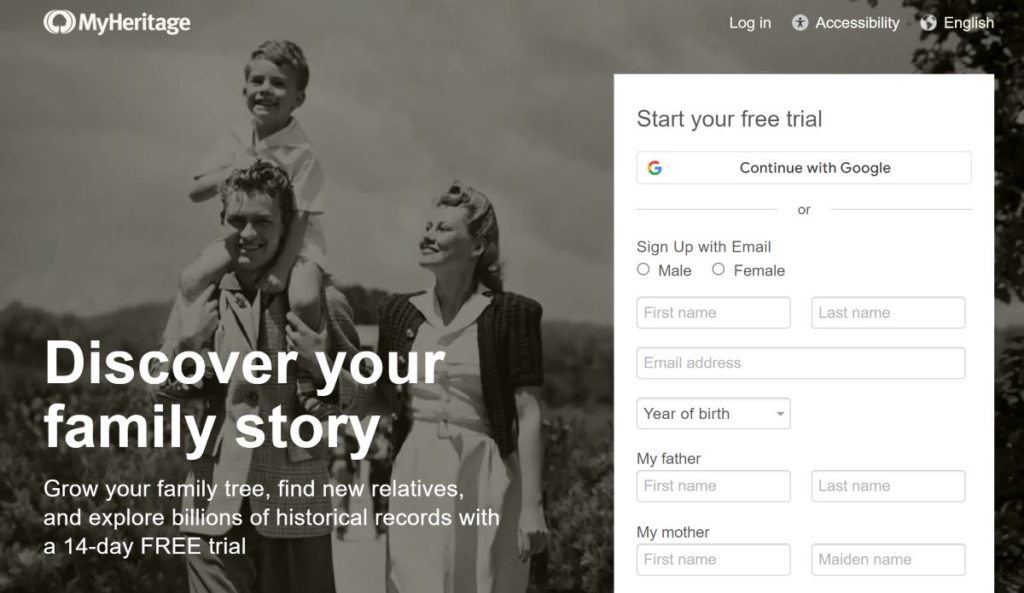Are you looking to build your family tree for free? Then you have come to the right place.
Here at 64smiles, we love two things, looking at old and vintage photos and building family trees.
We started building our family tree many years ago. It is now so much easier than when we started with many millions of records available online and lots of tools to help.
In this guide, we will share our top tips to help you build the perfect family tree. We will show you how to do it quickly and easily and best of all for free.
See how you can create your own photo family tree in minutes with 64smiles.
Making your family tree and discovering who you are related to is something that takes time and commitment. However, it is well worth it. It is such a rewarding hobby, one that can bring a wealth of previously unknown facts, exciting discoveries and maybe secrets revealed.
5 Steps to Building Your Perfect Family Tree
1. Learn All About Family Trees
Who Do You Think You Are? (Also know as WDYTYA?)
That’s the name of the famous TV series where celebrities explore their ancestry. It can be a fascinating journey and one that any person and family can undertake.
Discovering your lineage, gathering information about your ancestors and tracing your family history can be a very interesting and life changing.
And one of the most popular ways to show a family’s lineage is the family tree.
What is a Family Tree?

A family tree is simply a nice way to show the people in your family, your parents, grandparents and ancestors from further back.
It outlines the relationships and connections between them and how they connect to you.
A family tree is so called because like all trees, it has a root, branches and leaves. The root is the family name, the trunk is what hold the relationships together. The branches span out, with the oldest generations of your family at the top of the tree and the youngest members at the bottom.
Each family member on your tree can be represented by a box or circle, a leaf even, containing information such as their name, dates of birth, marriage, death, possibly a photograph if you have one. The branches are drawn to connect each family member to their parents, siblings, children, and other relatives such as uncles and aunts, cousins etc.
Benefits of Creating a Family Tree – Is it Worth it?
Building your family tree and discovering your ancestors is like completing a never-ending puzzle, one will keep you occupied and entertained for hours.
But lets face it, creating a family tree will take time.
It will involve time spent researching and searching, chatting to relatives and even popping down many rabbit holes to follow clues.
But is it worth building your family tree? Well, of course, here at 64 cousins we say yes!.
We outline seven reasons why building your family tree is a must-do – read more.
Two key reasons why building a family tree is important are:
- Firstly, not only is researching and building your family tree an exciting and engaging hobby, it is also a fantastic way to discover just who you are. You are a product of your ancestors. They have made you who you are and once you start delving in, you will learn perhaps why you have certain skills, like certain things or look the way you do.
- Secondly, with DNA profiling, you can also use your findings to help plan for the future. For example, identifying potential genetic risks or knowing medical issues that can be passed down to future generations.
The Importance of Knowing Your Family Tree

We believe that knowing your family tree is of great importance.
It holds the key to your personal and cultural identity. It also provides a sense of belonging, helping you forge stronger connections with your relatives, greater connections perhaps with parents and grandparents.
The family tree you build now can be shared and passed to future generations. They will benefit from the wealth of knowledge you have gathered and they too can appreciate their heritage.
Building Your Family Tree is Exciting

The more you discover the more you want to keep on discovering.
Imagine uncovering some long-lost family secret and sharing it with your family? This happens all the time, even where someone things their family is boring or ordinary.
2. Plan Your Perfect Family Tree
Our top tip when starting your family tree journey is a take a moment and create a plan. By having a plan and by being organised, you will find that the pieces fall into place much easier.
How do I Plan my Family Tree?
Before you start building your family tree, think about what you want to achieve.
Family trees can be simple or complex, depending on the amount of information you want to include and how far back you want to take your research. A simple family tree might only have your immediate family, such as your parents and grandparents, you and your brothers and sisters and children.
Perhaps you want to end up with a more complex and detailed family tree. This might go back many generations into the past. Or it can include extended family members making an extensive and expansive family tree that encompasses cousins and second or even third cousins.
You can add as much information to your family tree as you choose, such as birth dates, marriage dates, occupations, places they lived, awards and achievements, such as war commendations, inventions, scientific discoveries, authored books or important papers.
How to Start Your Family Tree – 6 Top Tips

- Start Jotting Down: You will be very surprised by what you already know. For a start, you will most likely know your closest relatives, parents, grandparents. Write down the names of the people around you. Include as much information as possible about them. Record their full names, dates of birth and any other relevant details, such as birthplaces or occupations.
2. Recall Family Stories: Try to remember and make a note of any stories you have heard regarding your ancestors. Perhaps they may seem like fantasy however quite often there will be a grain of truth. For example, a US based relative had heard stories when growing up about a Scottish relative who was fled the country in the 18th Century having been caught poaching deer. Only with later research did this story actually prove to be true.
3. Interview Living Relatives: Reach out to older relatives, such as parents, grandparents, aunts, and uncles, to gather more information about your extended family. Ask about their parents, siblings, and other relatives. Note down names, dates, and other anecdotes or stories they can share.
4. Dig Out the Family Archive: Is there a box of papers, documents or old family photos hidden in an attic or under a bed? Ignored for years and perhaps assumed worthless, you may find this is a treasure trove of valuable information to help you create your family tree. Blow the dust off, start sorting and arranging.
5. Collaborate with other family members: You may find that other members of your family, cousins are also in the process of creating a family tree. Perhaps they have already done so for their side of the family. Sharing information will save you both mountains of time.
6. Organise Your Findings: Organising and documenting every piece of information you come across is very important. This will help you prevent losing any key points.
There are several ways to document the data gathered. A simple old-fashioned pen and notebook are great. Store them via mail, your notes app, or a Word document.
For a more technical approach, use an Excel or similar spreadsheet. Create columns for each family member’s name, birth date, and any other relevant information like their gender, relationship status, number of kids , and so on.
3. Create Your Family Tree Diagram – (For Free)
Now the fun part!
We want to turn all that lovely information into something visual – something we can look at and share. In this section we will explore how to do that from a simple pen-and-paper approach, right up to dedicated software programs.
Go Online for Family Tree Inspiration
It is important to visualise how you want your family tree to look. You can draw inspiration from various sources like:
- Family trees of other people
- Image search on Google or Bing
- YouTube, TikTok and Instagram are also great sources for inspiration
- Pinterest search
Pinterest is the most recommended because it has a wide range of styles or ideas you can draw inspiration. It is also advised to draw whatever you have visualized in your head onto a piece of paper with a pen. This could help you decide if you truly like it or not.
How to Make a Family Tree on Paper in 5 Minutes

Having gathered your family history and found ideas of how you want your tree to look, we suggest drawing it out on paper.
This exercise takes just 5 minutes and when done you will have a sketch of your core family tree.
- Decide on the layout: Choose a traditional vertical or horizontal format, or get creative with a circular or tree-shaped design.
- You are the star: Begin by drawing a box or circle in the centre of the paper. This represents you, after all this is your tree.
- Add Your Parents: Draw two similar shapes just above yours, one for each of your parents. Connect their shapes to yours with two lines.
- Add Your Siblings: If you have brothers or sisters, draw additional lines extending from your parents’ boxes or circles to a box or circle represent each sibling. Place your siblings alongside you.
- Add generations: Now expand upwards and downwards to add your four grandparents, eight great grandparents, drawing lines to make the connections. Similarly move down below your box to add in your children and grandchildren of you have any.
- Label and Document: Ensure each individual, line, and symbol is clearly labelled with names, birthdates, and any other relevant information. Consider using abbreviations or codes to save space if needed.
That’s it – your 5-minute family tree.
Spend a little more time and you can expand it to include marriages and children, i.e. your cousins. Bear in mind that it may get very large and you will need additional sheets of paper.
At this stage, perhaps its time to look at a family tree tool or program to make it easier.
Create Your Family Tree Layout With Free Tools

While there are paid for online family tree builders or templates, you can make your own from scratch using some free design tools.
You should check out the following:
Canva: This is a popular design tool with a wide range of templates, including that of a family tree. It is quite simple and easy to use, making it easy for you to customize your family tree design to your taste. It is free for individuals to use with additional paid premium features.
Lucidchart: It is a web-based diagramming or visualization tool. It offers the opportunity to use various shapes, connectors, and other customization features to build your family tree. This also comes with a free version which will be more than adequate for a single-family tree,
Adobe Illustrator: This professional design software offers advanced graphic design features and options. You can start your design on a blank slate if you want. With Adobe, you fully control the layout and design elements. You get a free 7-day trial after which you will have to pay a monthly fee,
Use Online Family Tree Platforms – Free Trial

Ready to take your family tree to the next level?
The drawing tools mentioned above are great for creating beautiful family trees. When you are ready to take it further, then consider one of the online genealogy platforms. Not only will they create your family tree visual they also provide access to millions of records and documents.
They are excellent sources of information for creating a family tree.
These platforms provide users with access to historical records, census data, and all other useful kinds of information . Many of them also offer additional features like free DNA testing and family tree-building templates.
The downside to trying out genealogy platforms is that they are not free. However, some of them offer a free trial period that you can take advantage of and utilize.
Some of the popular platforms are:
- Ancestry.com
- Familysearch.org
- MyHeritage.com
Dedicated Family Tree Software (Not Free)
An alternative to using the online platforms is to download family tree software. In this way, you have direct control over your data and information as it is all stored locally on your computer. Afterward, you can back up your family tree to cloud storage or sync it to other online trees.
There are several effective genealogy software programs to build your master family tree. You should note that they are mostly paid. However, most of them offer a free trial or a free version with basic features.
The two most popular options are:
- Family Tree Maker
- Rootsmagic
Create your photo family tree with 64 Cousins
With 64 Cousins you can create a photo family tree in just a few minutes. Login, add your relatives, then add and tag photos and the system will create a beautiful family tree.
Learn more about 64cousins here.
4. Expand and Update Your Family Tree
Now that you have built your basic family tree and created the visual, the next step is to expand it.
This is the exciting part as you start to look expand it. You might find exciting new information or even trace a relative you never knew you had.
Once you have documented your direct lineage, expand your family tree to include siblings, cousins, and other collateral relatives. This will help create a more comprehensive and interconnected picture of your family.
In this section we look at how to add depth to your family tree with historical records, how to enrich it, sources of genealogy documents. We also look at using DNA testing to enhance your family tree research.
Where do I Find Family Tree Records?

There are several places where you can find family tree records to assist you in your genealogy research. Here are some common sources:
Vital Records Offices: Visit or contact the local government offices responsible for vital records, such as birth, marriage, and death certificates. These records often provide essential details about your ancestors, including names, dates, and locations.
Census Records: Census records are a valuable resource for tracing family history. Many countries conduct regular population censuses, and these records often contain information about individuals, their households, occupations, and relationships.
Church Records: Church records can be rich sources of genealogical information, particularly for baptisms, marriages, and burials. Contact local churches or religious institutions to inquire about accessing their records.
Online Databases: Numerous online genealogy platforms, such as Ancestry.com, MyHeritage, and FamilySearch, offer vast collections of historical records. These platforms allow you to search for and access birth, marriage, death records, census data, and more.
National Archives and Libraries: National archives and libraries house extensive collections of historical records, including census records, military records, immigration records, and land records. Research the archives and libraries in your country to identify relevant repositories .
How to Make my Family Tree More Interesting?

Revisit your relatives: To get more detailed information about your family history to add to your tree is to talk to your parents , grandparents, aunts, uncles, and other relatives. They may have documents, photos, or stories that can help you fill in the gaps in your family tree and enrich your document with interesting information to make your deceased relatives come to life.
Visit graveyards: A tad morbid perhaps, but graveyards are a great source of family history, This is especially relevant in Ireland where the census records for the whole of the 19th century going back to the first in 1821 were destroyed. This happened during the civil war in 1922 when an explosion destroyed the Public Records Office where all of these ancestral records were stored .
Historical Societies: Local historical societies often collect and preserve historical records specific to their region. They may have archives, documents, photographs, or manuscripts related to local families that can provide insights into your family history.
Online Forums and Communities: Participate in genealogy forums, social media groups, and online communities dedicated to family history research. These platforms often have members who can offer guidance, share resources, and provide assistance in finding family tree records.
DNA Testing Companies: DNA testing companies like 23andMe, AncestryDNA, and MyHeritage DNA not only provide ethnicity estimates but also offer tools to connect with genetic relatives. This can lead to new discoveries and the sharing of family tree information.
Local Historical Newspapers: Historical newspapers often contain birth announcements, marriage notices, obituaries, and other valuable genealogical information. Check with local libraries, archives, or online newspaper archives to access these resources .
How to Verify Information in Your Family Tree
While researching, it’s essential to verify the accuracy of the information you find.
Cross-reference multiple sources to confirm dates, names, and relationships. Be mindful of potential discrepancies or errors in official records .
Remember, more recently, the assumed name change to take on a husband’s surname on marriage occurs less, and double-barrelled names, keeping maiden names and couples of the same sex sharing names etc., mean you should verify and keep clear records of birth names to guide your search.
5. Share and Enjoy Your Family Tree

Sharing your family tree with your immediate and extended family will inspire them and encourage more collaboration where they can supply you with additional information or photographs to make your family tree more substantial, rich and absorbing.
- Print Your Family Tree: Create a physical copy of your family tree using a genealogy software or design tool and print it out. Frame it and display it in your home, where family members and visitors can easily see and discuss it.
- Organise a family reunion: Family reunions are an excellent opportunity to meet relatives you may not have met before and to learn more about your family history. Ask those attending in advance to bring any interesting documents and photographs that could contribute to your research. Most older family members will be thrilled to be asked to help with your research and fill any gaps. It can be valuable for passing on family stories and links that need to be documented on paper.
- Share via Online Family Tree Platforms: Share your family tree on popular online genealogy platforms like Ancestry.com, MyHeritage, or FamilySearch. These platforms allow you to create and share your family tree with relatives, collaborate on research, and discover connections with other users. See how 64smiles makes sharing your photo family tree easy.
- Family Tree Websites: Create a dedicated family website or blog where you can showcase your family tree. Include photographs, stories, and relevant historical information to engage and inform visitors. Encourage family members to contribute their own insights and memories.
- Use Social Media: Use social media platforms like Facebook or Instagram to share snippets and highlights from your family tree. Post photos, stories, and interesting facts about ancestors or significant family events. Engage with family members through comments and discussions.
It is well worth considering digitalising your old family photos, documents, and memorabilia to add to your family tree record and preserve them for future generations.
What Not to Do When Building a Family Tree – Mistakes to Avoid
- Don’t jump straight in with a full-blown, final document copy : You will likely make many adjustments and changes, so save the fancy stuff until you are sure. A rough drawing is less work and more easily adapted as you start expanding and adding generations.
- Wait to do the pretty copy till you have the records for as far back as you want to go in place if you can use an online tree building system to help you keep track of family member placement.
- Don’t assume family names have always been spelt like they are now. Commonly, surnames and how they are spelt have changed over the centuries and between varying branches of the same family, so don’t be put off by some of the different spellings you encounter.
- Remember that creating a complete picture of your ancestors could quite possibly uncover some family secrets that other family members have tried to keep hidden or were unaware of, so always be sensitive when and with whom you share your findings!
- It is also possible amongst many historical records that there are spelling errors; in the past, lying about age and even marital status wasn’t uncommon. Christian names, surnames, and transposed names are common, as well as differences in age, through lies and mistakes. Don’t immediately rule out some minor differences as being the wrong person. When the change from the Julian to the Gregorian calendar occurred in the 16th-century means, you could see two dates or different dates to those you were expecting pretty commonly.
- Don’t forget to document your sources to enable quick fact-checking, and it is easier to write down where you gleaned the information as you come across it than trying to track it down later.
- It may seem obvious, but it is easy to skip a generation without realising, so pay particular attention to the birth and death dates you find and be careful with tracking the parentage line to ensure that no generations are skipped. Remember that many generations ago, the generations could be much closer in age than we see today .
Finally, Remember to Enjoy Your Family Tree Journey
Creating a family tree should be exciting and something you do for fun, so remember to enjoy it and take it at a pace that you are comfortable with.
Perhaps challenge yourself to uncover something new every day or week to keep your focus and interest.
That way, you’re sure to enjoy the process of building your family tree as well as the end result.


